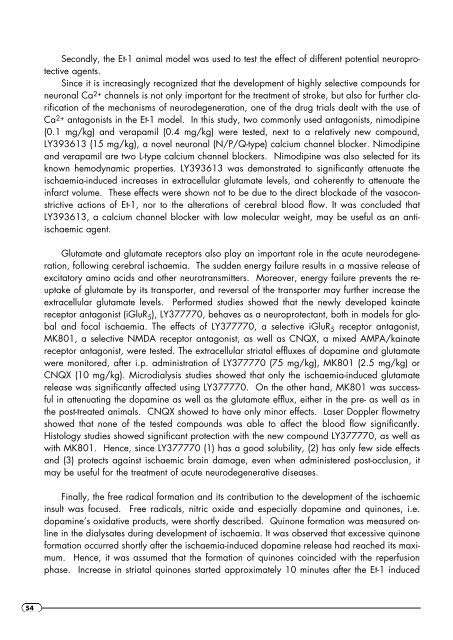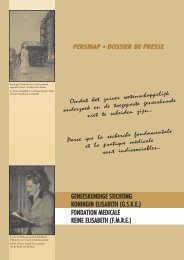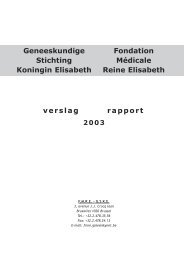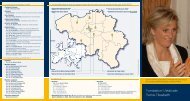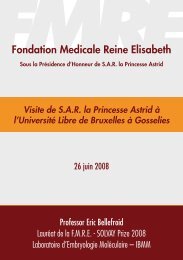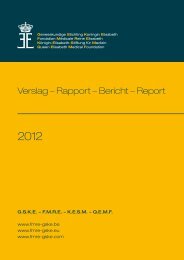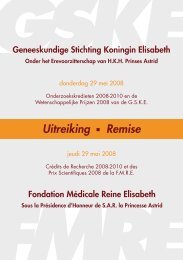Geneeskundige Stichting Koningin Elisabeth ... - GSKE - FMRE
Geneeskundige Stichting Koningin Elisabeth ... - GSKE - FMRE
Geneeskundige Stichting Koningin Elisabeth ... - GSKE - FMRE
Create successful ePaper yourself
Turn your PDF publications into a flip-book with our unique Google optimized e-Paper software.
54<br />
Secondly, the Et-1 animal model was used to test the effect of different potential neuroprotective<br />
agents.<br />
Since it is increasingly recognized that the development of highly selective compounds for<br />
neuronal Ca 2+ channels is not only important for the treatment of stroke, but also for further clarification<br />
of the mechanisms of neurodegeneration, one of the drug trials dealt with the use of<br />
Ca 2+ antagonists in the Et-1 model. In this study, two commonly used antagonists, nimodipine<br />
(0.1 mg/kg) and verapamil (0.4 mg/kg) were tested, next to a relatively new compound,<br />
LY393613 (15 mg/kg), a novel neuronal (N/P/Q-type) calcium channel blocker. Nimodipine<br />
and verapamil are two L-type calcium channel blockers. Nimodipine was also selected for its<br />
known hemodynamic properties. LY393613 was demonstrated to significantly attenuate the<br />
ischaemia-induced increases in extracellular glutamate levels, and coherently to attenuate the<br />
infarct volume. These effects were shown not to be due to the direct blockade of the vasoconstrictive<br />
actions of Et-1, nor to the alterations of cerebral blood flow. It was concluded that<br />
LY393613, a calcium channel blocker with low molecular weight, may be useful as an antiischaemic<br />
agent.<br />
Glutamate and glutamate receptors also play an important role in the acute neurodegeneration,<br />
following cerebral ischaemia. The sudden energy failure results in a massive release of<br />
excitatory amino acids and other neurotransmitters. Moreover, energy failure prevents the reuptake<br />
of glutamate by its transporter, and reversal of the transporter may further increase the<br />
extracellular glutamate levels. Performed studies showed that the newly developed kainate<br />
receptor antagonist (iGluR 5), LY377770, behaves as a neuroprotectant, both in models for global<br />
and focal ischaemia. The effects of LY377770, a selective iGluR 5 receptor antagonist,<br />
MK801, a selective NMDA receptor antagonist, as well as CNQX, a mixed AMPA/kainate<br />
receptor antagonist, were tested. The extracellular striatal effluxes of dopamine and glutamate<br />
were monitored, after i.p. administration of LY377770 (75 mg/kg), MK801 (2.5 mg/kg) or<br />
CNQX (10 mg/kg). Microdialysis studies showed that only the ischaemia-induced glutamate<br />
release was significantly affected using LY377770. On the other hand, MK801 was successful<br />
in attenuating the dopamine as well as the glutamate efflux, either in the pre- as well as in<br />
the post-treated animals. CNQX showed to have only minor effects. Laser Doppler flowmetry<br />
showed that none of the tested compounds was able to affect the blood flow significantly.<br />
Histology studies showed significant protection with the new compound LY377770, as well as<br />
with MK801. Hence, since LY377770 (1) has a good solubility, (2) has only few side effects<br />
and (3) protects against ischaemic brain damage, even when administered post-occlusion, it<br />
may be useful for the treatment of acute neurodegenerative diseases.<br />
Finally, the free radical formation and its contribution to the development of the ischaemic<br />
insult was focused. Free radicals, nitric oxide and especially dopamine and quinones, i.e.<br />
dopamine’s oxidative products, were shortly described. Quinone formation was measured online<br />
in the dialysates during development of ischaemia. It was observed that excessive quinone<br />
formation occurred shortly after the ischaemia-induced dopamine release had reached its maximum.<br />
Hence, it was assumed that the formation of quinones coincided with the reperfusion<br />
phase. Increase in striatal quinones started approximately 10 minutes after the Et-1 induced


